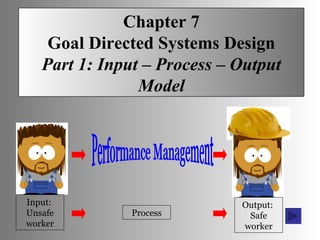Gdsd workshow
•Download as PPS, PDF•
1 like•1,101 views
The document provides an overview of goal-directed systems design (GDSD) for designing an ideal structure of organizational goals using a behavioral systems analytic approach. It discusses key concepts like defining organizations as systems with inputs, processes, and outputs. Several practice activities are included to help identify the input, process, and output components of different behavioral systems like hospitals, bookstores, and amusement parks.
Report
Share
Report
Share

Recommended
Recommended
More Related Content
Similar to Gdsd workshow
Similar to Gdsd workshow (20)
[GAN by Hung-yi Lee]Part 2: The application of GAN to speech and text processing![[GAN by Hung-yi Lee]Part 2: The application of GAN to speech and text processing](data:image/gif;base64,R0lGODlhAQABAIAAAAAAAP///yH5BAEAAAAALAAAAAABAAEAAAIBRAA7)
![[GAN by Hung-yi Lee]Part 2: The application of GAN to speech and text processing](data:image/gif;base64,R0lGODlhAQABAIAAAAAAAP///yH5BAEAAAAALAAAAAABAAEAAAIBRAA7)
[GAN by Hung-yi Lee]Part 2: The application of GAN to speech and text processing
Solves Multi- step Routine and Non-routine Problems involving Division and an...

Solves Multi- step Routine and Non-routine Problems involving Division and an...
Teaching Lean Workshop Shs Asq Poole Hinton Kraebber 2010 02 25

Teaching Lean Workshop Shs Asq Poole Hinton Kraebber 2010 02 25
Problem Formulation in Artificial Inteligence Projects

Problem Formulation in Artificial Inteligence Projects
PERSONAL CHAPTER TAKEAWAYS Action Plan – Tunnel Vision .docx

PERSONAL CHAPTER TAKEAWAYS Action Plan – Tunnel Vision .docx
How to solve daily, chronic problems in your business with concepts from Poly...

How to solve daily, chronic problems in your business with concepts from Poly...
More from Julie Sanchez
More from Julie Sanchez (20)
Gdsd workshow
- 1. Performance Management Input: Unsafe worker Process Output: Safe worker Chapter 7 Goal Directed Systems Design Part 1: Input – Process – Output Model
- 19. Goal-Directed Systems Design is a technology for designing an ideal structure of organizational goals using a behavioral systems analytic approach .
- 23. What’s the behavioral systems analysis approach ?
- 130. Rules Define processes of an organization as activities or behaviors . Use “[verb] + ing + [noun]” or “to [verb] [noun]” to define a process. Example: Baking bread, or to bake bread. Define outputs , inputs , or goals of an organization as things or conditions . Avoid using “[verb] + ing + [noun]” or “to [verb] [noun]” to define an output/input. Instead, Use [adjective] + [noun] to define inputs/outputs. Example: Baked bread. Return to Table of Contents Click to go back to your previous slide
- 167. Why is the Goal-Directed Systems Design important?
- 175. Why is the Goal-Directed Systems Design useful?
